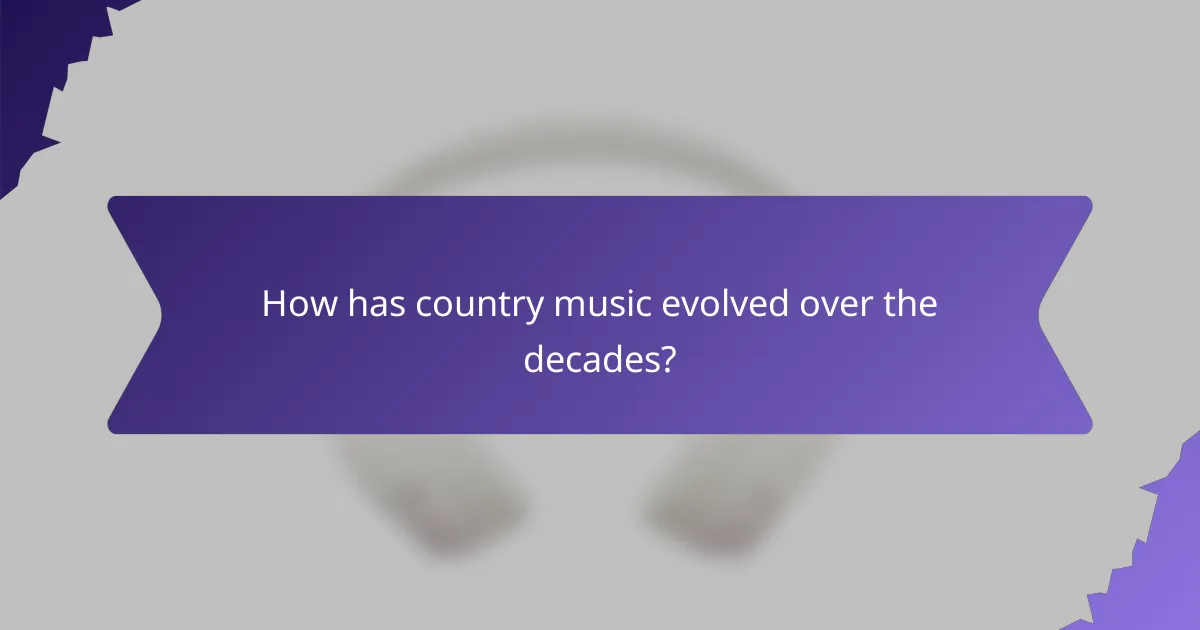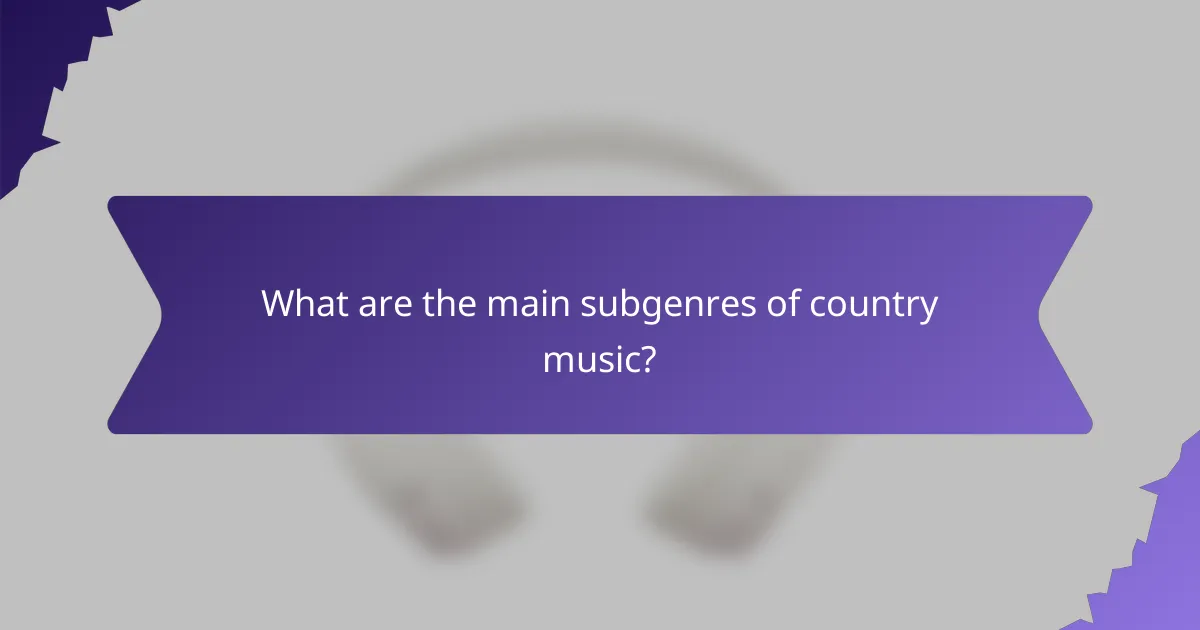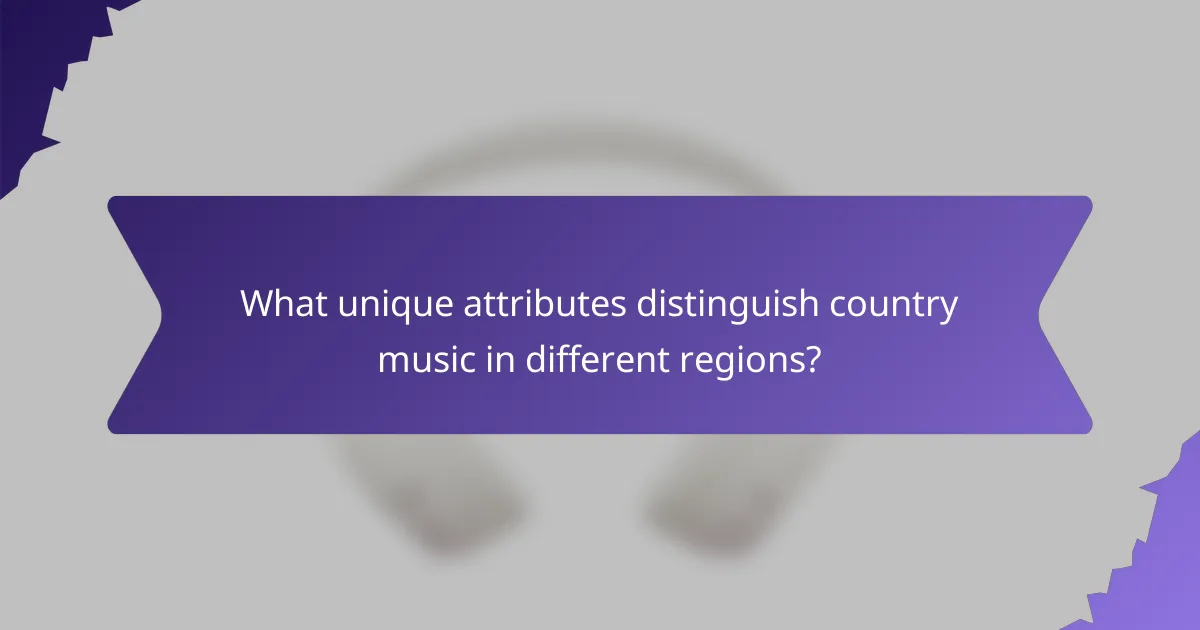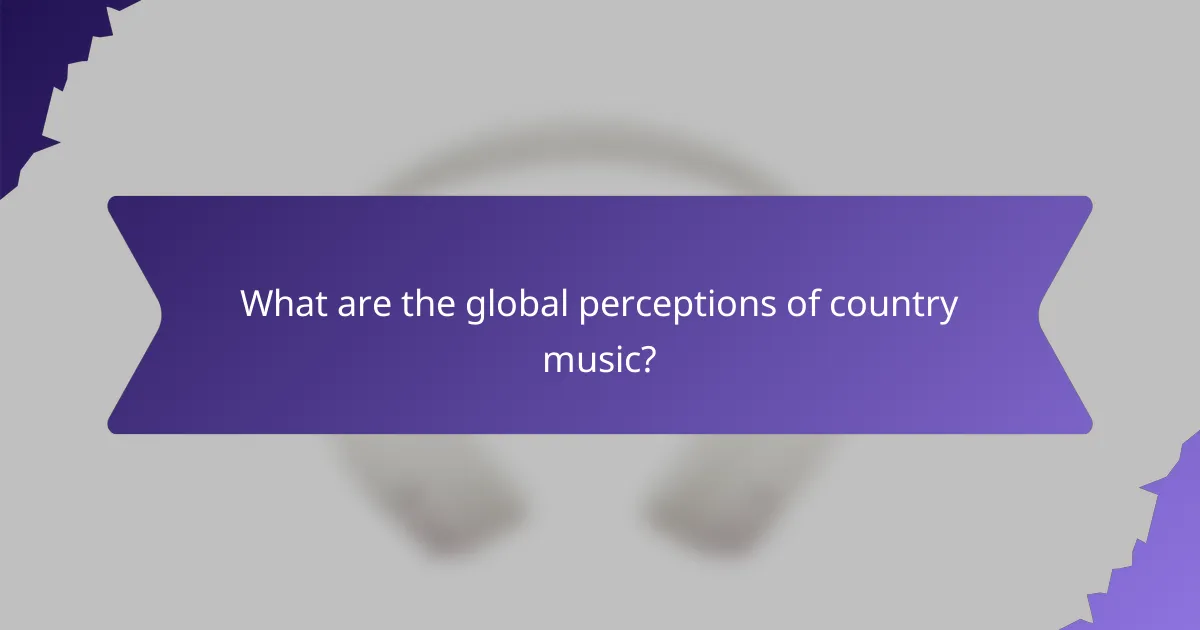Country music’s evolution reflects its adaptability and cultural significance. This article explores its diverse subgenres, regional influences, and how it addresses contemporary social issues. We will also examine the genre’s global perceptions and the technological advancements shaping its distribution. Through its storytelling, country music captures the essence of the American experience while resonating with audiences worldwide.

How has country music evolved over the decades?
Country music has evolved significantly over the decades, incorporating diverse influences and subgenres. Initially rooted in folk traditions, it embraced honky-tonk and bluegrass in the mid-20th century. The late 20th century saw the rise of pop-country, blending mainstream appeal with traditional sounds. Today, genres like Americana and country rap showcase its adaptability. This evolution reflects broader cultural shifts, with artists often addressing contemporary issues through their music. The unique attribute of country music lies in its storytelling, which remains a defining feature across all its phases.
What were the key influences in the development of country music?
The key influences in the development of country music include folk traditions, blues, and the cultural backdrop of the American South. Early country music emerged from a blend of various musical styles, including Appalachian folk music and African American blues. The introduction of radio in the 1920s significantly expanded its reach, making artists like Jimmie Rodgers and the Carter Family widely popular. The genre has since evolved through subgenres like bluegrass and honky-tonk, reflecting its adaptability to cultural changes. Additionally, the impact of technology, such as the electric guitar and recording innovations, has shaped its sound and style over decades.
How did the Nashville sound shape modern country music?
The Nashville sound significantly influenced modern country music by blending traditional elements with pop and rock influences. This genre emerged in the 1950s, characterized by smooth vocals and orchestral arrangements. Artists like Patsy Cline and Jim Reeves exemplified this style, focusing on emotional storytelling.
The Nashville sound’s commercial success helped shape the industry’s direction, introducing a polished production style that appealed to broader audiences. As a result, modern country music often incorporates diverse genres, reflecting the Nashville sound’s legacy. This evolution showcases a unique attribute of country music: its adaptability and ongoing cultural impact.
What role did radio and television play in popularizing country music?
Radio and television significantly contributed to the popularization of country music by broadening its audience and enhancing its cultural reach. Radio broadcasts in the early 20th century introduced listeners to country music artists, while television showcased live performances, making the genre more accessible. Iconic shows like “Hee Haw” and “The Grand Ole Opry” featured country music prominently, establishing a visual connection with fans. This exposure helped country music evolve, incorporating diverse influences and subgenres, ultimately solidifying its place in American culture. Through these mediums, country music gained national recognition and transformed into a mainstream phenomenon.
Which historical events impacted the trajectory of country music?
Several historical events significantly impacted the trajectory of country music. The Great Depression in the 1930s led to a rise in folk music, influencing artists like Hank Williams. World War II created a demand for morale-boosting music, shaping the genre’s patriotic themes. The Nashville Sound emerged in the 1950s, blending pop elements and broadening the audience. The Civil Rights Movement in the 1960s introduced social commentary, leading to songs addressing racial issues. The advent of digital technology in the 2000s transformed music distribution, allowing independent artists to thrive. Each event contributed to the evolution and cultural impact of country music.

What are the main subgenres of country music?
Country music features several main subgenres, including traditional country, bluegrass, country rock, and contemporary country. Each subgenre showcases unique characteristics and influences. Traditional country emphasizes storytelling and acoustic instruments, while bluegrass incorporates fast tempos and complex harmonies. Country rock blends rock elements with country themes, and contemporary country often includes pop influences and modern production techniques. These subgenres reflect the evolution and cultural impact of country music across different eras.
How does traditional country differ from contemporary country?
Traditional country music emphasizes storytelling and acoustic instrumentation, while contemporary country incorporates pop elements and broader themes. Traditional country often features themes of rural life and personal struggles, whereas contemporary country explores diverse topics like love, partying, and urban experiences. The instrumentation in traditional country relies heavily on instruments like the fiddle and banjo, while contemporary country often includes electric guitars and synthesizers. Overall, traditional country maintains its roots in folk traditions, while contemporary country evolves to appeal to a wider audience.
What defines outlaw country and its cultural significance?
Outlaw country is defined by its rebellious spirit and authenticity, reflecting themes of individualism and social critique. This subgenre emerged in the late 1960s, challenging the polished sound of mainstream country music. Artists like Willie Nelson and Waylon Jennings emphasized raw storytelling and a connection to the struggles of everyday life.
Culturally, outlaw country represents a significant shift in music, advocating for artistic freedom and self-expression. It resonates with audiences seeking genuine narratives over commercialized content. The movement has influenced various genres, promoting a broader acceptance of diverse musical styles and themes within country music.
Outlaw country continues to inspire new generations of musicians, fostering a legacy of authenticity and resistance against conformity in the music industry. Its impact is evident in the works of contemporary artists who draw from its ethos, ensuring its relevance in today’s cultural landscape.
Which artists are prominent in bluegrass and what are its characteristics?
Prominent bluegrass artists include Bill Monroe, Earl Scruggs, and Alison Krauss. Bluegrass features fast tempos, intricate instrumentation, and tight harmonies.
Bill Monroe, known as the “Father of Bluegrass,” established the genre’s signature sound. Earl Scruggs revolutionized banjo playing with his three-finger picking style. Alison Krauss brought bluegrass to mainstream audiences, blending it with country and folk.
Key characteristics of bluegrass include the use of acoustic instruments like the mandolin, banjo, fiddle, and upright bass. The genre often incorporates improvisation and showcases vocal harmonies, typically featuring high tenor leads. Bluegrass songs frequently draw on themes of rural life, love, and loss.
How has country pop influenced mainstream music?
Country pop has significantly shaped mainstream music by blending traditional country elements with pop sensibilities. This fusion has led to a broader audience for country music and influenced various genres. Notable artists like Taylor Swift and Kacey Musgraves exemplify this crossover, integrating catchy melodies and relatable lyrics that appeal to diverse listeners.
The incorporation of pop production techniques, such as polished instrumentation and hooks, has made country music more accessible. As a result, country pop has introduced elements like storytelling and authenticity to mainstream pop, enriching the overall musical landscape. This evolution continues to inspire new artists and reshape industry trends.

What unique attributes distinguish country music in different regions?
Distinct regional influences shape country music’s unique attributes, reflecting local culture and traditions. In the South, elements of blues and gospel create a soulful sound, while Western styles incorporate storytelling and folk influences. The Midwest emphasizes a polished, commercial sound, often blending pop elements. Appalachia showcases traditional instruments like the banjo, highlighting its roots in folk music. Texas country often features a blend of rock and traditional styles, emphasizing a unique lyrical perspective. Each region contributes distinct flavors that enrich the overall genre.
How do Southern and Western influences manifest in country music?
Southern and Western influences manifest in country music through distinct musical styles, lyrical themes, and cultural storytelling. Southern influences often highlight themes of love, heartache, and rural life, while Western influences incorporate elements of cowboy culture and expansive landscapes.
The instrumentation also varies, with Southern country frequently featuring fiddles and banjos, whereas Western styles may emphasize acoustic guitars and harmonicas. Notably, the blending of these influences has led to subgenres like honky-tonk and Americana, enriching the genre’s cultural tapestry.
Historically, artists such as Hank Williams and Johnny Cash exemplify these cross-cultural influences, shaping the genre’s evolution. As a result, contemporary country music continues to draw from both Southern and Western roots, reflecting a diverse musical heritage.
Which artists represent the unique sound of Texas country?
Artists like George Strait, Miranda Lambert, and Cody Johnson represent the unique sound of Texas country. Their music blends traditional country elements with regional influences, showcasing storytelling and authenticity. George Strait, known as the “King of Country,” has a distinctive style that emphasizes classic country sounds. Miranda Lambert incorporates a modern twist while maintaining Texas roots, and Cody Johnson brings a fresh perspective with his blend of honky-tonk and contemporary influences. These artists exemplify the rich cultural tapestry of Texas country music.
What are the characteristics of Americana music and its relationship with country?
Americana music blends elements of country, folk, blues, and rock, reflecting American roots. Its relationship with country music is significant, as Americana often embraces storytelling and traditional instrumentation found in country. Americana emphasizes authenticity and cultural narratives, while country music has evolved into diverse subgenres, including pop-country and outlaw country. Both genres share common themes of love, hardship, and the American experience, contributing to their cultural impact and evolution.

How does country music reflect cultural and social issues?
Country music reflects cultural and social issues by addressing themes of identity, hardship, and community. It often narrates personal stories that resonate with listeners, highlighting experiences related to love, loss, and resilience.
The genre has evolved, incorporating influences from various musical styles, which enables it to address contemporary social issues such as economic struggles and social justice. For instance, songs like “Where Were You (When the World Stopped Turning)” by Alan Jackson capture the emotional landscape following significant events, showcasing the genre’s ability to respond to societal shifts.
Country music’s roots in storytelling allow artists to convey messages about cultural values and social norms. The unique attribute of this genre lies in its authenticity, as artists often draw from personal experiences, making their narratives relatable. As a result, country music serves as a reflection of the American experience, capturing both regional and national sentiments.
In recent years, there has been a notable rise in songs addressing mental health and inclusivity, reflecting a broader societal awareness. This evolution indicates how country music continues to adapt and respond to the changing cultural landscape, maintaining its relevance in contemporary discussions.
What themes are commonly explored in country lyrics?
Country lyrics commonly explore themes of love, heartache, family, and rural life. They often reflect personal stories and cultural values, emphasizing the emotional connection to these experiences. Additionally, themes of resilience, nostalgia, and celebration of everyday life frequently appear, showcasing the unique attributes of country music’s storytelling tradition.
How has country music responded to social movements?
Country music has increasingly embraced social movements, reflecting societal changes and advocating for various causes. Artists have addressed issues like racial equality, mental health, and LGBTQ+ rights through their lyrics and public statements.
Notable examples include the response to the Black Lives Matter movement, where artists like Mickey Guyton and Kacey Musgraves highlighted racial injustice. Furthermore, country music has seen a rise in songs promoting mental health awareness, such as “Follow Your Arrow” by Kacey Musgraves, which encourages acceptance.
The genre’s evolution includes collaborations across genres, amplifying voices from different backgrounds. This shift indicates a broadening perspective within country music, aligning it with contemporary social issues.
Overall, country music’s response to social movements showcases its cultural impact and adaptability, making it relevant in today’s social landscape.
Which notable songs address political themes?
Several notable country songs address political themes, reflecting social issues and cultural sentiments. Examples include “Where Were You (When the World Stopped Turning)” by Alan Jackson, which contemplates the impact of 9/11, and “Travelin’ Soldier” by Dixie Chicks, highlighting the emotional toll of war. “The Night the Lights Went Out in Georgia” by Vicki Lawrence critiques the justice system, while “American Soldier” by Toby Keith honors military service. These songs showcase the genre’s ability to engage with pressing societal concerns.

What are the global perceptions of country music?
Global perceptions of country music vary widely, reflecting its rich history and cultural significance. In the United States, country music is often associated with themes of rural life, love, and storytelling, resonating deeply with fans. However, in other parts of the world, such as Europe and Asia, country music is sometimes viewed as niche or even exotic, with a growing fan base that appreciates its authenticity and emotional depth.
The genre has evolved significantly, incorporating elements from pop, rock, and blues, which has broadened its appeal. Subgenres like Americana and bluegrass have gained traction, showcasing the diversity within country music. Additionally, artists like Kacey Musgraves and Chris Stapleton have contributed to a modern renaissance, attracting new listeners globally.
Cultural impact is notable; country music festivals attract thousands, fostering community and cultural exchange. The genre’s influence on fashion, language, and lifestyle is evident, as it often shapes perceptions of American culture abroad. Overall, country music continues to evolve, bridging gaps between traditional and contemporary sounds, while its global perception remains a tapestry of admiration, curiosity, and evolving tastes.
How is country music received in non-Western countries?
Country music is increasingly embraced in non-Western countries, often blending with local genres. This cultural exchange fosters unique subgenres, enhancing the global appeal of country music. For instance, in countries like Japan and Australia, country music festivals attract diverse audiences, showcasing its adaptability. Additionally, artists from these regions incorporate traditional elements, creating a fusion that resonates with local listeners. This evolution highlights country music’s ability to transcend cultural boundaries, making it a global phenomenon.
Which international artists have incorporated country elements into their music?
Several international artists have successfully incorporated country elements into their music. Notable examples include Shania Twain, who blends pop and country, and Kacey Musgraves, known for her crossover appeal.
Taylor Swift, originally a country artist, transitioned to pop while retaining country influences. Keith Urban, an Australian musician, merges country with rock and pop. Additionally, the Zac Brown Band features reggae and country fusion. These artists showcase the genre’s versatility and global reach.
What festivals celebrate country music worldwide?
Numerous festivals celebrate country music globally, showcasing its rich cultural impact. Notable examples include the CMA Fest in Nashville, Tennessee, which attracts thousands of fans each year. The Stagecoach Festival in California also highlights diverse country music acts, featuring both established and emerging artists. The Big Valley Jamboree in Alberta, Canada, is another significant event that celebrates country music with performances and community activities. Additionally, the Country to Country (C2C) festival spans multiple European cities, bringing American country music to international audiences. Each of these festivals underscores the genre’s evolution and its ability to unite fans worldwide.

What role does technology play in the production and distribution of country music?
Technology significantly enhances the production and distribution of country music by streamlining processes and expanding reach. Digital audio workstations allow artists to record high-quality music from home studios, reducing production costs. Streaming platforms like Spotify and Apple Music enable global distribution, allowing artists to connect with wider audiences. Social media serves as a promotional tool, helping artists build fan bases and engage with listeners directly. The integration of data analytics informs marketing strategies, optimizing release schedules and promotional efforts. This technological evolution has transformed country music, making it more accessible and diverse.
How has streaming changed the way country music is consumed?
Streaming has significantly transformed country music consumption by increasing accessibility and engagement. Listeners can now access a vast library of songs and artists from anywhere, fostering a more diverse audience.
Streaming platforms have enabled country music to reach global markets, allowing artists to connect with fans beyond traditional boundaries. This shift has encouraged the emergence of new subgenres, blending country with pop, rock, and hip-hop influences.
Data indicates that streaming has led to a rise in collaborations among artists, enhancing creativity and innovation within the genre. As a result, streaming not only changes how country music is consumed but also shapes its cultural impact and evolution.
What innovations in recording have influenced country music sound?
Innovations in recording have significantly shaped the sound of country music. The introduction of multi-track recording allowed artists to layer instruments and vocals, enhancing the overall richness of the sound. Digital recording technology has further enabled greater precision and creativity in production.
The use of electric instruments, such as the electric guitar, transformed traditional acoustic sounds, leading to the emergence of subgenres like country rock. Additionally, advancements in sound engineering techniques, including reverb and compression, have refined the auditory experience.
Finally, the rise of home recording software has democratized music production, allowing aspiring country artists to create high-quality recordings independently. This shift has diversified the country music landscape, fostering innovation and experimentation.
How do social media platforms impact country music marketing?
Social media platforms significantly enhance country music marketing by providing direct engagement with fans and targeted advertising. These platforms allow artists to share content instantly, fostering a personal connection with audiences. For example, platforms like Instagram and TikTok enable musicians to showcase their music and lifestyle, driving fan interaction.
Additionally, social media analytics provide valuable insights into audience demographics, helping artists tailor their marketing strategies. The rise of viral challenges and trends, particularly on TikTok, has led to unexpected hits, illustrating the unique attribute of social media’s influence on song popularity.
Furthermore, collaborations with influencers amplify reach, making it easier for new artists to gain visibility. As a result, social media has transformed traditional marketing methods, allowing country music to evolve and reach diverse audiences.
What are the best practices for engaging with country music audiences online?
Engaging with country music audiences online requires authenticity, consistency, and community interaction. Focus on storytelling that resonates with the culture and values of country music. Utilize platforms like Instagram and TikTok to share behind-the-scenes content, artist interviews, and fan stories.
Encouraging user-generated content fosters community and strengthens connections. Highlighting rare attributes, such as unique subgenres or local artists, can attract niche audiences. Regularly hosting live sessions or Q&As enhances engagement by allowing fans to connect directly with artists.